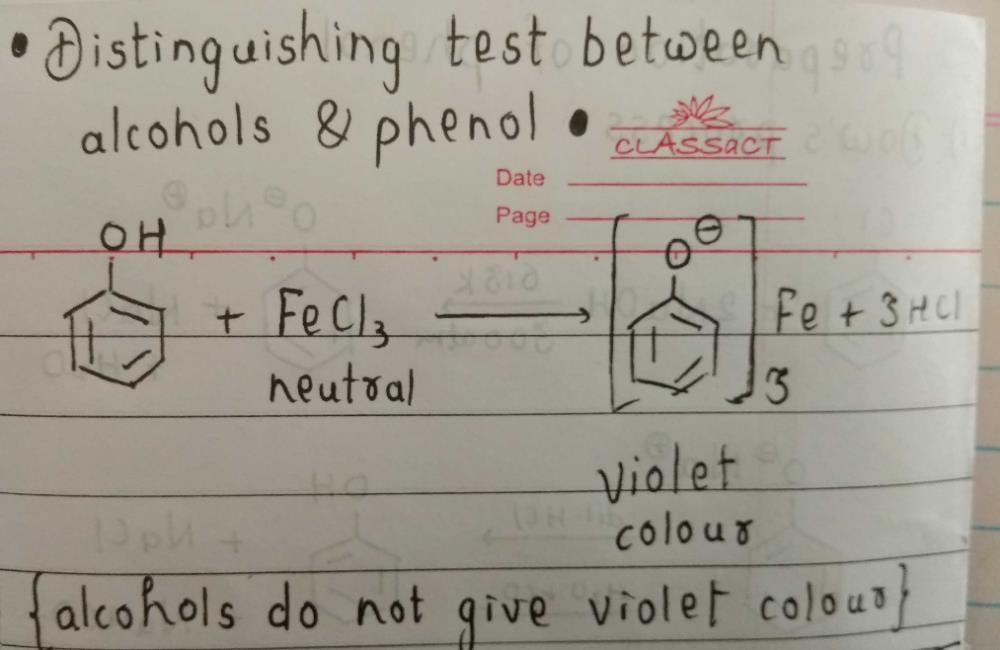Class 12 Exam > Class 12 Questions > Phenol is treated with neutral FeCl3?
Start Learning for Free
Phenol is treated with neutral FeCl3?
Most Upvoted Answer
Phenol is treated with neutral FeCl3?
Phenol Treatment with Neutral FeCl3
Phenol is an organic compound with the chemical formula C6H5OH. It is an aromatic compound and is commonly used in the production of plastics, pharmaceuticals, and other chemicals. Neutral FeCl3 is a common reagent that is used to react with phenol. The reaction between phenol and neutral FeCl3 is an important way to produce compounds known as aryl chlorides.
Reaction Mechanism
Phenol reacts with neutral FeCl3 to produce an intermediate complex, which then undergoes a substitution reaction to form an aryl chloride. The mechanism of this reaction is as follows:
1. Formation of the intermediate complex: FeCl3 reacts with phenol to form an intermediate complex, which is stabilized by the formation of a hydrogen bond between the oxygen atom of phenol and the chloride ion of FeCl3.
2. Substitution reaction: The intermediate complex then undergoes a substitution reaction, where the chloride ion is replaced by a chlorine atom from the phenol molecule. This results in the formation of an aryl chloride.
Uses of Phenol Treatment with Neutral FeCl3
The reaction between phenol and neutral FeCl3 has several important uses in organic chemistry, including:
1. Production of aryl chlorides: The reaction between phenol and neutral FeCl3 is an important way to produce aryl chlorides, which are important intermediates in the synthesis of many organic compounds.
2. Preparation of pharmaceuticals: Phenol is a starting material for the production of many important pharmaceuticals, and the reaction with neutral FeCl3 is an important step in the synthesis of these compounds.
3. Production of plastics: Phenol is also used in the production of many types of plastics, including polycarbonates and epoxies. The reaction with neutral FeCl3 is an important step in the synthesis of these materials.
In conclusion, the treatment of phenol with neutral FeCl3 is an important reaction in organic chemistry. It is used to produce aryl chlorides, which are important intermediates in the synthesis of many organic compounds. The reaction is also important in the production of pharmaceuticals and plastics.

|
Explore Courses for Class 12 exam
|

|
Similar Class 12 Doubts
Phenol is treated with neutral FeCl3?
Question Description
Phenol is treated with neutral FeCl3? for Class 12 2024 is part of Class 12 preparation. The Question and answers have been prepared according to the Class 12 exam syllabus. Information about Phenol is treated with neutral FeCl3? covers all topics & solutions for Class 12 2024 Exam. Find important definitions, questions, meanings, examples, exercises and tests below for Phenol is treated with neutral FeCl3?.
Phenol is treated with neutral FeCl3? for Class 12 2024 is part of Class 12 preparation. The Question and answers have been prepared according to the Class 12 exam syllabus. Information about Phenol is treated with neutral FeCl3? covers all topics & solutions for Class 12 2024 Exam. Find important definitions, questions, meanings, examples, exercises and tests below for Phenol is treated with neutral FeCl3?.
Solutions for Phenol is treated with neutral FeCl3? in English & in Hindi are available as part of our courses for Class 12.
Download more important topics, notes, lectures and mock test series for Class 12 Exam by signing up for free.
Here you can find the meaning of Phenol is treated with neutral FeCl3? defined & explained in the simplest way possible. Besides giving the explanation of
Phenol is treated with neutral FeCl3?, a detailed solution for Phenol is treated with neutral FeCl3? has been provided alongside types of Phenol is treated with neutral FeCl3? theory, EduRev gives you an
ample number of questions to practice Phenol is treated with neutral FeCl3? tests, examples and also practice Class 12 tests.

|
Explore Courses for Class 12 exam
|

|
Signup for Free!
Signup to see your scores go up within 7 days! Learn & Practice with 1000+ FREE Notes, Videos & Tests.




















